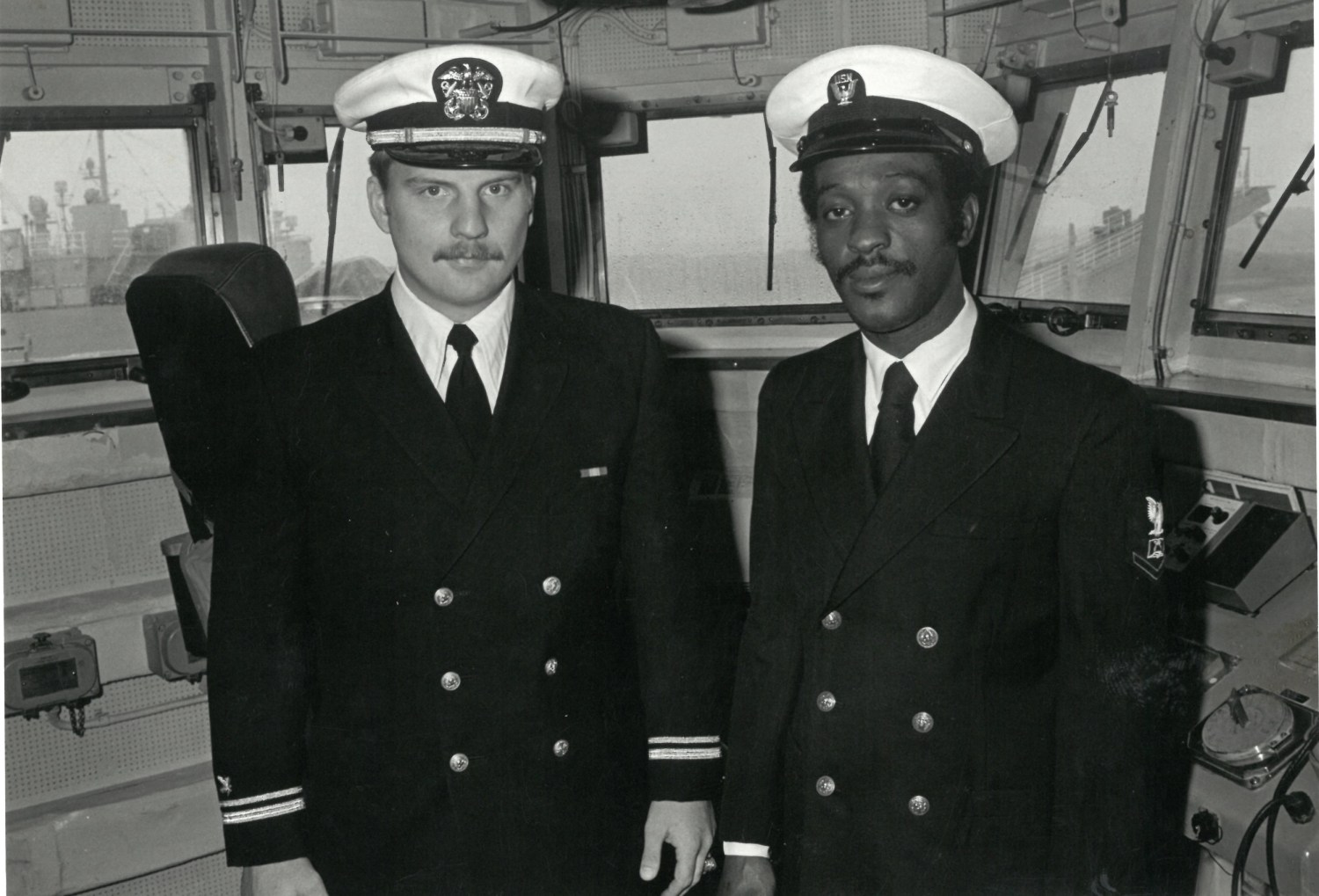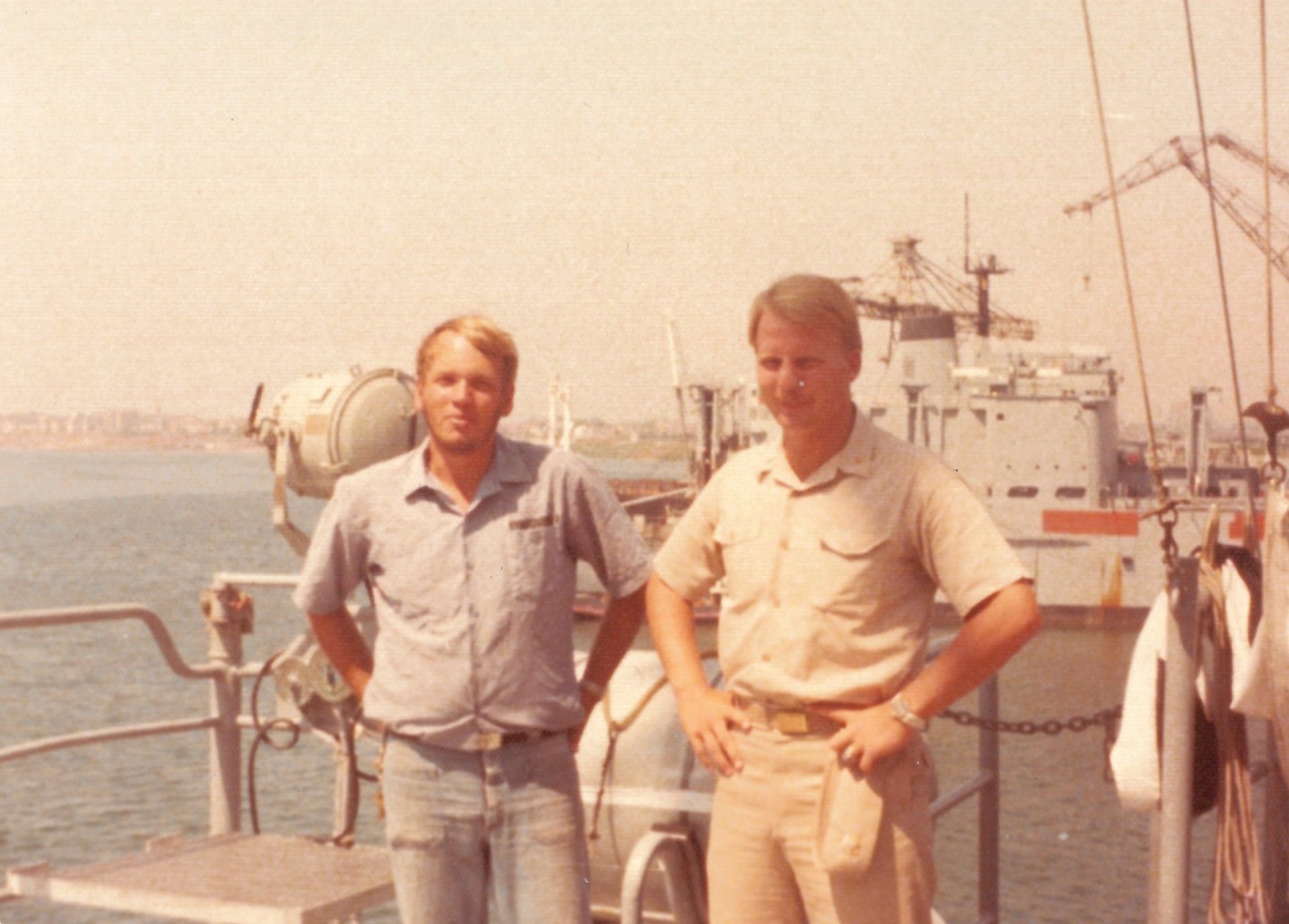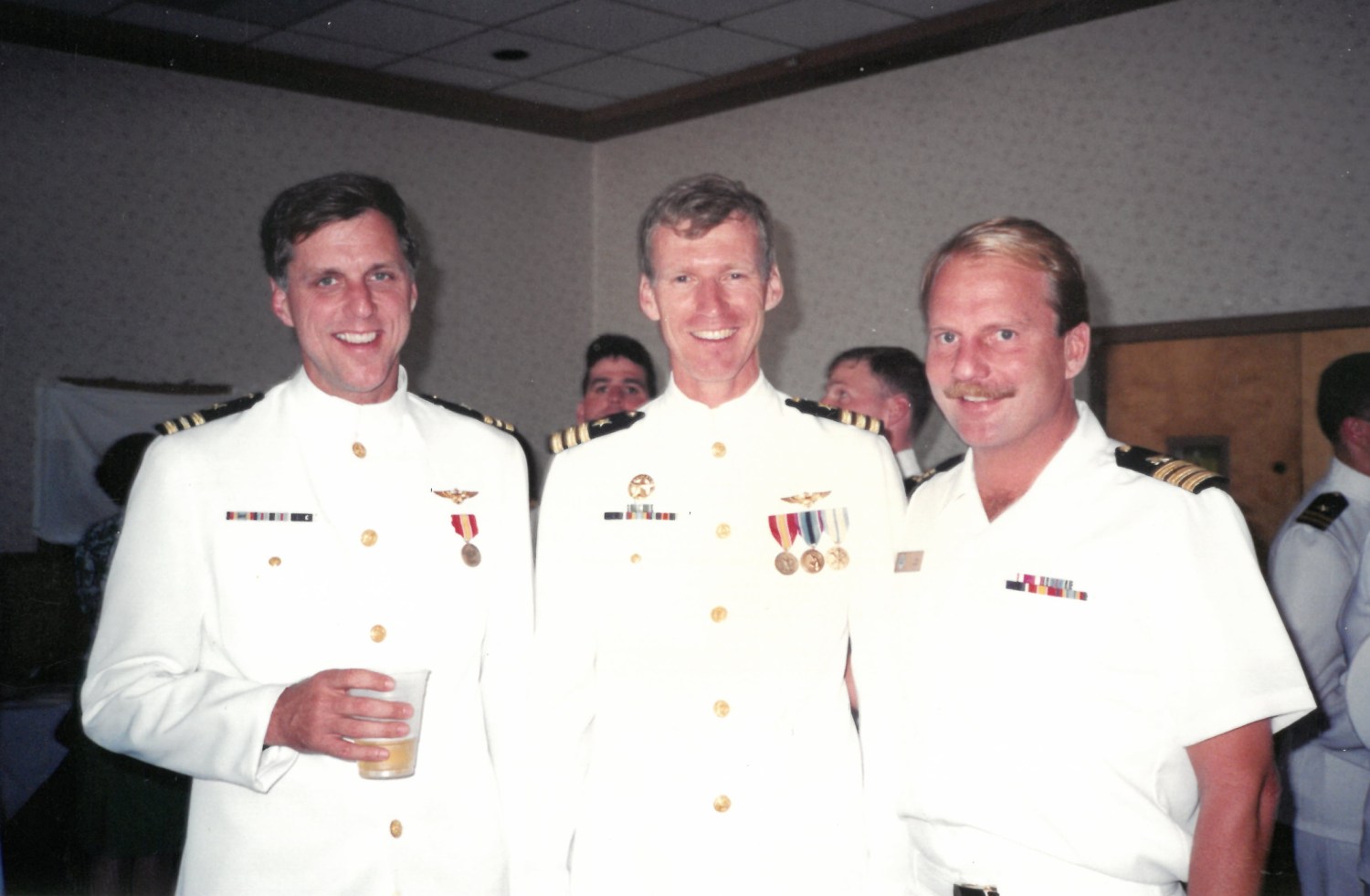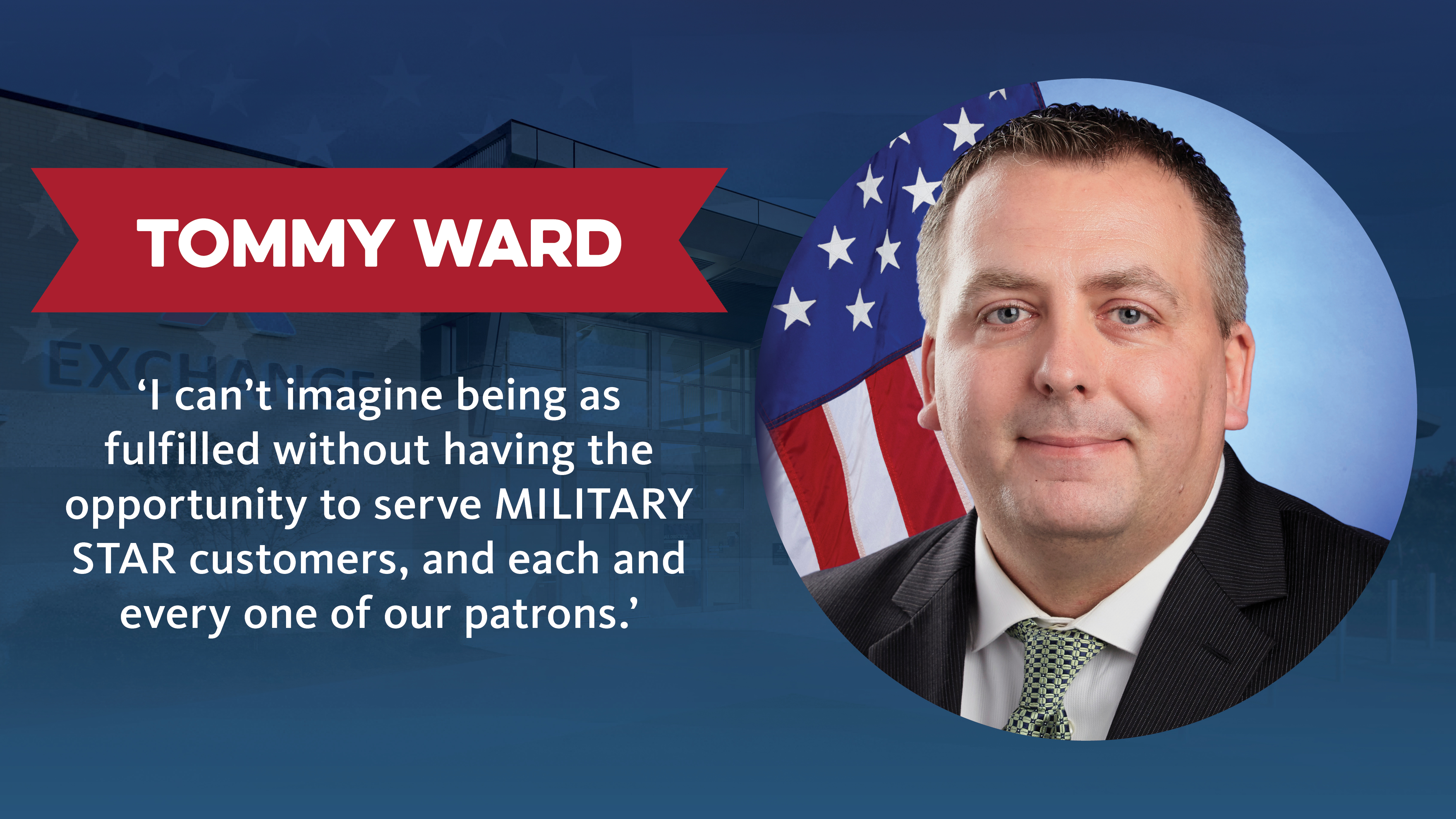The first thing Tom Lozier bought from the Army & Air Force Exchange Service was a TV, which he ordered from a catalog. He was serving in the Navy, and Sailors could order from the Exchange catalog when they were at sea.
The first place he used the TV was in Iceland, his first duty station after he graduated from the U.S. Naval Academy in 1974.
“It was a Sony Trinitron, very small, for my room in the Bachelor Officer Quarters,” said Lozier, the Exchange’s chief administrative officer and executive vice president. “It was a color TV, but everything in Iceland at the time was in black and white, and I was in Iceland for a year. So I never really used the color aspect of it until I moved back to the States.”
It was in Iceland, where he served during the Cold War, that Lozier first saw the full impact of an exchange.
“It was a very strategic base because Russian submarines were coming out of their ports, so they had to go by Iceland,” he said. “The exchange there was huge for all the families. It was a Navy Exchange, and we knew the delivery dates. There was always a big crowd and a lot of people hung around there. It was an American place to be.”
There were other exchanges during Lozier’s nearly 25-year military career. After active duty, he became a reservist and worked in the civilian business world before coming full circle and starting at the Exchange in 2012 as vice president of the Logistics Directorate.
In 2020, he became chief administrative officer, the position he will retire from at the end of July.
“AAFES has been a good fit for me,” he said. “It’s a feel-good job, in that I know how important it is and what the end result is going to be. I’m so proud to tell people where I work.”

A military family
Lozier’s father and two of his father’s brothers served in World War II. His father was a paratrooper who jumped into Europe on June 7, 1944—D-Day Plus One. He served in the Battle of the Bulge, the brutal late 1944-early 1945 battle in which Allied forces spent 41 wintry days fighting off attacking German forces. His father was awarded a Purple Heart for injuries sustained there.
One of Lozier’s uncles served on a Navy destroyer; another was in the Army, serving in Burma (now Myanmar). A third volunteered to serve in the Navy even thought he was exempt because of a “sole survivor” policy designed to keep at least one family member safe from fighting in case the worst happened to the others during their service. Fortunately, all returned safely.
Lozier’s father did not talk about the war much—or want to.
“I remember vividly, just the two of us were in his bedroom, getting something out of his closet, and I asked him about his World War II experience,” Lozier said. “And he looked at me and just said, ‘Don’t ever ask me any more questions about that.’ He wasn’t being mean, but just by the look on his face, I got the message.”
His family’s military background influenced Lozier’s decision to join the military, but athletics did too. A star linebacker on his high school football team in Michigan, Lozier was recruited by the Naval and Air Force academies.
“I received a letter from Army, too, and from other schools,” Lozier said. “I originally was going to go to Central Michigan University but after talking to my dad about contributing to our country and the benefits of the military, I decided that Navy was the way I wanted to go.”
Lozier entered the Naval Academy in 1970. As a football player, he didn’t see much action.
“I was a weekday warrior,” he said. “I played with the practice team. But I got injured my plebe year, as soon as we started practicing. That kind of pushed me out. And it was a different level from high school.
“Where I grew up in Michigan is about a half-hour from Ann Arbor,” he added. “Navy played Michigan back then and I got a big thrill out of dressing in football uniform for the games.”
While he was at Annapolis, Lozier got to see leadership in action. What he observed influenced his own style.
“It was leadership 24/7,” he said. “It wasn’t just being in a class, it was learning it firsthand and learning what worked for me. I looked at what motivated me, what types of leadership styles got me excited and which types did not. I learned how to treat people and how not to treat people.”
At first, Lozier wasn’t sure if he wanted to make the Navy a career but he found it fulfilling and enjoyable. “I stayed on active duty for 12 years and then served another 12½ years in the Reserves,” he said. “Naval Reserve was a little bit different from Army and Air Force. We did ours in a group, so I was a commanding officer of a couple of Reserve units. With all the weekends added up, I probably put in about a month a year. And there were two weeks solid of active duty each year.”
After he left active duty, Lozier entered the civilian world, where he made a crucial connection.

Meeting Mr. Shull
Lozier graduated from the Naval Academy in 1974—a year after Exchange Director/CEO Tom Shull graduated from the U.S. Military Academy at West Point. This was just the beginning of nearly parallel and eventually intersecting paths.
After graduation, Lozier attended Navy Supply Corps School in Athens, Georgia and was then sent to Iceland. All major service branches were represented there, and one of Lozier’s responsibilities was to move cargo from a Naval Air Station to an Army post with a classified location.
After about year in Iceland, he was sent to Norfolk, Virginia, where he served as the supply officer aboard a tank landing ship. When a Canadian Armed Forces officer was sent to work at a supply center in San Diego, Lozier moved to Canadian Forces Base Borden, just north of Toronto, and taught leadership and probability and statistics courses at the base’s logistics school.
While he was there, he was selected for a program to earn his master’s degree in business administration. The Navy gave him a list of schools he could apply to and said it would foot the bill. He was accepted into Harvard.
“That’s how I got to know Tom Shull,” he said. “I graduated from the MBA program in ’82, and I overlapped with Tom, who was ’81. We had a really close mutual friend who was in my Harvard class and had been a West Point classmate of Tom’s.”

Entering the civilian world
Lozier wanted to be a Navy pilot, but a medical issue prevented that. Although he could still serve, he couldn’t become an aviator. He was offered a choice of going into the Corps of Engineers or JAG Corps. JAG didn’t interest him but logistics did.
“I enjoyed logistics a lot,” he said. “I pretty much stayed in it in my civilian career. I knew how important logistics was and how it was overlooked a lot. Nobody really thinks about how items go places and where they’ve been. That’s what made me stay—and the challenges. There was always a challenge—something goes wrong somewhere and it’s got to be fixed. And I liked that.”
After he graduated from Harvard, he went to work at what is now Navy Exchange Command in Virginia Beach, Virginia. He discovered that he liked retail. He had also stayed in touch with Shull, leading to a key step in the mid-’80s.
“At the time, Tom was working at Sanger-Harris, which was a department store chain in Dallas,” he said. “They had an open position there in logistics. I was recruited and got a job there through Tom.”
A year or so after Lozier’s arrival, Shull left to work for consulting firm McKinsey & Co., where he stayed until 1990. The same year, Lozier started his own company, Warden West Corp., which provided third-party logistics support to department stores such as Macy’s—where Shull came to work in 1992, serving in a series of executive roles.
“He was at Macy’s headquarters in New York, and I was working at Macy’s West,” Lozier said. “I was an independent contractor running their West Coast distribution center.”
They both worked in the civilian business world for more than 20 years before Shull was named Director/CEO of the Exchange in June 2012. Lozier, who had been working as an independent consultant at the time, joined the Exchange a few months later as vice president of logistics.
Among the events happening when Lozier arrived was the Afghanistan War, during which the Exchange provided support for several U.S. camps and air bases in Southwest Asia. Lozier’s military experience helped him rise to the challenge.
“Having been on a ship, having been to Iceland, having been to other places, I knew how important Exchange benefits are for the troops,” he said. “And how important the Exchange is for morale and what it does for readiness. I’d remembered the lines in Iceland outside the Navy Exchange, when a plane had come in the day before and people knew that another fresh batch of merchandise would be in that store. It really makes a difference in people’s lives.”
In 2014, Lozier was promoted to senior vice president of supply chain transportation, a role he served in until 2020, when he was named chief administrative officer. He assumed that role, overseeing the Real Estate, Loss Prevention and Equal Employment Opportunity directorates, in March 2020—just as the COVID pandemic was starting. But the transition was relatively easy.
“The IT Directorate had already started setting people up for remote work,” he said. “They already had a lot of experience with it when COVID hit. It didn’t take them long to get everybody set up so that we could work remotely.”
A bigger challenge happened in February 2021, when pipes burst at Dallas headquarters during a historic winter storm. The resulting flooding endangered a data center known as the heartbeat of the Exchange. IT and Real Estate associates worked around the clock, protecting the data center, checking hundreds of computers for damage and then reconnecting them by hand.
“That was bad, all the damage that it did, and having to work through that,” Lozier said. “But it was another example of solving problems together as a team.”
Retirement plans
After retirement, Lozier plans to move from the Dallas area to the Tidewater region of southeast Virginia—an area he served in as a Sailor, worked in as a civilian and regularly visited as a member of Team Exchange (the Dan Daniel Distribution Center and Joint Base Langley-Eustis Exchange are both in the area).
“I have a lot of Navy friends there,” Lozier said. “And my kids, who are young adults now, said, ‘Dad, wherever you want to go, just make sure it’s a place we’d like to go visit even if you weren’t there.’”
He also plans to use his free time to play golf and travel, and he serves on the board of a small company that meets a couple of times a year, so he plans to continue doing that.
But he’ll always carry the Exchange with him.
“It’s all about the people,” he said. “The customers we serve and the teammates we work with. I know how important we are and what we do is. It makes me feel, after having been in the Navy, that I am part of the family.”
Lozier said that when he goes into an Exchange, he prefers to do it unannounced, with associates not realizing that he’s one of organization’s top executives.
“The last time I was in one, I didn’t mention who I was, and I was treated like a king,” he said. “It was great. I don’t know any other way to describe it. It certainly feels good.”
If you’d like to wish Tom Lozier well on his retirement journey, please comment on this story.





Leave a Reply